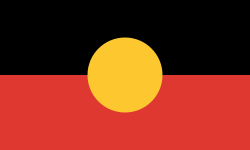All I need to do now is go to New Zealand. It may sound odd, but it is true: I have to go to New Zealand in order to become a resident of Australia. It is not because Australian residents must be acquainted with the country's best friend (though that would be very cute); in fact, I can travel anywhere outside of Australia, and upon re-entering, I begin my journey of becoming Australian (this has to do with the fact that I applied outside of Australia). The closest "anywhere" to Sydney is none other than New Zealand, where we'll be going in September. So I have quite a bit of time to consider what it means to become Australian....
Enjoying a "soy-dandy" at Badde Manors in Glebe
Last Sunday, the two candidates for the position of prime minister had their first debate. I watched, and learned about the strange life of Australian politics. For one, the opposition candidate (Tony Abbot from the Liberals [more right]) is best known for his "budgie smuggler." A truly beautiful expression, and incredibly vivid, but also quite crass -- thought no one seems to mind this. It took me a while to figure out what a budgie smuggeler is, but, to put it as simply as possible, "budgie" is the abbreviation for a small Australian parrot, the budgerigar. Now imagine, if you were trying to smuggle an Australian parrot into another country, where would you hide it?
A budgie smuggler is nothing other than a speedo men's swim suit! And the opposition candidate famously wears this when he goes swimming, just around the corner at Manly Beach.
Abbott began his part of the debate with a dinky-di Australian expression: "fair go." Then he followed it up with "fair dinkum," saying something along the lines of: "If we want to be fair dinkum about this, Julia..." Well, Julia responded quickly: "I am glad you brought up 'fair dinkum', Tony, because that is exactly what we need to be," and the rest of the evening degenerated into fair dinkum this and fair dinkum that. It was possibly one of the most used expressions of the evening -- other than Julia's famous "moving forward." Fair dinkum means genuine, authentic, the real thing (in German Bodenständig might be a good translation). And "dinky-di" means "true-blue" -- as in dinky-di Australian (which I will never become). Much of the debate, unfortunately, remained vague and revolved around such expressions, leaving much to be desired.
In the meantime, I've been hanging laundry on Australia's best invention -- Hill's Hoist (no idea why it hasn't made it outside of Australia) -- and learning one particularly beloved Australian poem, "My Country." It is sentimental, but it does capture the extremes of the Australian landscape, and weather. This is the part that our friend (and fifth-generation Aus.), Lee, particularly likes:
A land of sweeping plains,
Of ragged mountain ranges,
Of droughts and flooding rains.
I love her far horizons,
I love her jewel-sea,
Her beauty and her terror -
The wide brown land for me!
I actually have some of the "brown land" on my desk; a friend gave me a bit of red sand from Uluru to welcome me to Australia. It was not until she went to Uluru and communicated with the rock, she told me, that she felt at home in Australia. After New Zealand -- Uluru!


































